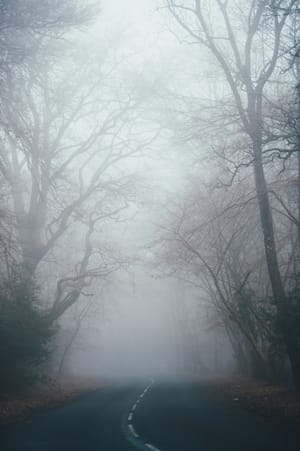by Laura Holt
“…On a cold, dark, rainy night…so bitterly cold, damp, and dark…when even street lights won’t burn, and the striking of a match refuses to yield the tiniest flame…on nights like this, Huggin’ Molly comes out of her lair and roams the streets of Abbeville to see whom she can find.”
So begins the legend of Huggin’ Molly. My granny told me this story many times when I was a child, normally when I wanted to play outside after dark and she wanted me to stay indoors. She’d heard it from her mama, who’d grown up learning about this ghostly cryptid from her grandmother, who was born in Abbeville, Alabama before moving to Georgia as a girl.
As the story goes, Molly is a phantom-like, seven-foot-tall woman dressed in black with a wide-brimmed hat that hides her face in shadow who roams the streets after dark. If a child is out past sundown, she jumps out at them, squeezes them tight, and screams in their ear.
Although Molly seems relatively harmless when compared to other monsters of my childhood, like the title-named beast in Stephen King’s Cycle of the Werewolf, the idea of a ghostly specter lurking behind a hedge waiting to grab me was still enough to give me pause. And as an adult, I find myself fascinated with how our ancestors used folklore as a way to pass down the tales of their heritage while simultaneously keeping the younger generations in line.
One of the most popular versions of the Huggin’ Molly story is that she was a woman who tragically lost her child and was driven mad by grief, causing her to wander the streets at night. She sought out other children to hug in an attempt to cope with her sorrow. Another paints her as the vengeful spirit of a murdered woman who seeks justice for her death by looking out for other young people out alone at night to prevent them from meeting a similar fate. Some believe she was a witch ala Hansel and Gretel squeezing children to see if they were plump, and others say she was a teacher at the former Alabama Agriculture School who was trying to get her students off the streets at night to keep them safe.
But is she real?
It’s no secret that Abbeville, like all southern towns, has a dark and tragic past. From European settlers struggling to survive in a harsh new world, slavery, the atrocities committed against the Creek Nation, and the harsh reality that African Americans faced every day during the segregation, to lynchings and acts of sexual violence against women that more often than not went unpunished, it’s highly plausible that Molly’s legend grew out of a very real fear of being out on the streets after dark. Yet there have also been documented sightings of this mysterious woman in black since the 1900s.
In 1920, Mack Gregory, an Abbeville native, was walking home from his high school job as a grocery store delivery boy. It was getting late, and he thought he sensed someone behind him. He turned around to check and saw a figure following him a-ways back. It stuck to the shadows, but he was able to see it was very tall, feminine, and dressed all in black. Mack reported later that he was nervous and started to walk faster, but the figure increased its pace to keep up. When he slowed down, thinking to confront whoever it was, the figure slowed too. That’s when he knew it was Huggin’ Molly, and he ran the rest of the way home, not stopping until he’d slammed the door behind him. When he looked out the window, the ghostly specter was gone. But her message stayed with him, and he never did another night delivery again.
A similar report came a few years later from the mother of another teenager who was late getting home. Worried about where her son might be, she’d gone onto the porch to see if she could see him. Sure enough, there he was, hurrying up the sidewalk. Only her relief was short-lived when she saw a second, darker figure coming up fast behind him, long arms outstretched. She screamed at him to run, which he did, and she held the door open until he was safely in the house, then shut and bolted it before the ghost could follow him.
The most recent sighting that I was able to find happened in 2010. A local teacher was leading a cemetery tour for the town’s annual heritage festival when a ghostly figure in black appeared between the headstones. She stated that it vanished almost as quickly as it had come, but that everyone in the group had seen it and were badly shaken.
So, I decided to take a road trip to Abbeville and get to the bottom of this super-sized spook myself.
Cue the Sweet Home Alabama refrain.
Abbeville is about a two-and-a-half-hour drive from my hometown in Middle Georgia along Highway 27. With my windows down, I rolled south past fields of wildflowers, roadside stands selling everything from produce to Huggin’ Molly t-shirts, one very questionable gas station restroom, and lots of cows until, finally, I reached the quaint little southern town where Huggin’ Molly supposedly resides. Famished from my drive, I started my investigation at a 1950s-style restaurant downtown bearing the same name as my quarry. Inside among the vintage decor, I found newspaper printings of reported sightings, a beautifully illustrated print version of Molly’s story from 1956, and a monstrous-sized menu. I ordered Molly’s Fingers with a Golly Molly, and while they turned out to be chicken tenders with a chocolate dessert, they were still creeptastically delicious.
Feeling fortified after my meal, I made my way down Columbia Road to the Pioneer Cemetery. Here, tucked away behind First Baptist Church and shrouded beneath ancient oaks and low-hanging gray beard moss, I knelt in awe at the gravestone of the woman many believe was the inspiration for Huggin’ Molly. The inscription was a simple name, the life marked by birth and death dates, and I marveled at the woman whose name and legend had persisted so long.
Of course, Molly is not the first spectral female who comes from a tragic past. Southern folklore is full of angry female ghosts. And I think the trope surrounding these types of ghostly females, the ones who are dealt a poor hand in life and come back after death to punish those who harmed them, tells us something about ourselves. It speaks to that deep-seated female rage, the one we all harbor inside for wrongs done to us, our loved ones, our sex, and which women have always used the telling of story as a way to voice.
Like my granny, great-granny, and great-great granny, women were often the keepers of oral stories, since before Title IX was passed in 1972 it was still very rare for a woman to attend school. Most middle and lower-class women of that time period never learned how to read or write, since they wouldn’t have had access to the same educational means as women from wealthy families. From rocking chairs on front porches, they used the power of story as a way to express their beliefs, thoughts, and emotions. To preserve feminine history, folk remedies, and family recipes, and to pass those things down to their daughters and granddaughters. And, as with the ones we discussed here, many times, they shaped them as cautionary warnings, to help other women learn how to safely navigate the dangerous waters of living in a man's world while also giving them powerful, often protective, heroines to look up to.
With Molly's permission, I took a rubbing of her headstone. Yet I could not help but wonder whether she was sleeping peacefully in eternal slumber beneath the ground or watching me from the shadows, and left the graveyard with more questions than answers.
By this time, it was getting dark. If I wanted to meet Huggin’ Molly up close and in person, now was my chance. So, I got out my equipment, made sure my troll cross was securely tied around my neck, and took to the streets to hunt for the South’s most elusive haint.
I wandered the main roads for about an hour, camera in hand in case I caught anything on film that wasn’t visible to the naked eye or ear. A strange wind stirred my hair, though the trees remained still. Despite it being late August, the night held an undeniable chill, as if I was in the presence of a specter. Once, I swore I even heard footsteps behind me, but when I turned around, no one was there.
As my watch crept toward ten o’clock, I decided to call it a night and headed back to my vehicle. Getting into the driver’s seat, I locked the doors, put the key in the ignition, and pulled up my phone, too eager to look through my footage to wait until I got home. At first, it was just a long reel of me walking around, narrating what I was doing, and filming my surroundings. Then, right near the end as I was passing the now-closed restaurant, I caught a flash of what appeared to be a disembodied shadow flit across the windows.
Heart pounding, I scrolled back to get a second look, but even in slow-motion, I was unable to determine exactly what it was I had captured on film. Was it merely my own shadow playing tricks on me? Or could I have been in the presence of Huggin’ Molly herself, protected by her ever-watchful eye as I meandered the dark streets?
I will never know for sure. But one thing is for certain. Whether Molly was a witch, a grief-stricken mother, the unfortunate victim of a violent crime, or a teacher taking care of her students in and out of the classroom, her legacy has lived on to this day, inspiring new generations of young people to practice safe traveling habits, create spooktacular concoctions, and that believing in something is better than not believing in anything at all.
So, the next time you’re in the Southern United States, swing on by the picturesque town of Abbeville and pay a visit to Molly. And if she decides to give you a hug? Well, you know just who to call: your Friendly Neighborhood Ghost Hunter.

